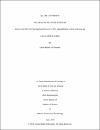| Abstract | Nowadays, one of the most critical issues in photovoltaic (PV) industry is the
fabrication of an efficient and low cost solar cells. The solar energy have to be more
efficient and cost effective than other electricity sources in order to be a major source of
electricity. Different types of photovoltaic materials have been developed over the past
century and the latest technology is based on thin film solar cells. Copper indium gallium
selenide (CIGS) thin film based solar cells have achieved more than 20% power conversion
efficiency. However, these materials are toxic, rare and expensive. Copper zinc tin sulfide
(CZTS) is a very promising material and a good alternative for CIGS thin film. CZTS
materials are cheap, non-toxic and abundant. Also, It has an ideal band gap of 1.5 eV and
a high absorption coefficient.
Single step electrodeposition technique was used to deposit CZTS thin film on
fluorine doped tin oxide (FTO) coated glass substrate. In order to identify the suitable
deposition potential, a set of CZTS thin films were deposited at different potentials. The
used potentials were -1.10 V, -1.20 V, -1.25 V, -1.30 V, and -1.35 V ( vs. Ag/AgCl). XRD
and Raman analysis were used to confirm the presence of CZTS kesterite phase. There was
a dependence for the intensity and FWHM of the (112) planes peaks which affect the
crystallite size. The sample deposited at -1.35 V had the highest crystal size and the best crystalline quality. The EDS and XPS measurements were performed and the best
stoichiometry was achieved in the sample deposited at -1.35 V.
The influence of sulfur amount in the sulfurization process on the CZTS thin films
was also investigated. So, a set of CZTS films was electrodiposited using -1.35 V and
sulfurized using 5 mg, 15 mg, 25 mg, 35 mg, and 50 mg of sulfur powder. The best CZTS
thin film stoichiometry and crystalline quality was achieved using 35 mg sulfur according
to XRD, Raman and EDS analyses. Uv-visible and Photoluminescence (PL) measurements
were used to study the optical properties of the electrodeposited films. The sample
electrodeposited at -1.35 V using 35 mg sulfur exhibited a 1.50 eV optical band gap and
104 cm-1 absorption coefficient. These results confirm the suitability of these films to be
utilized as absorber layers in thin film solar cell structures. |


